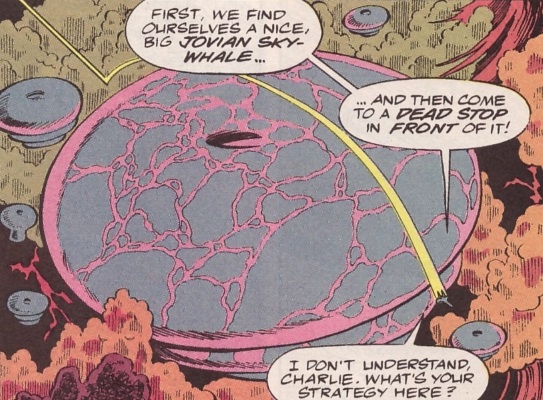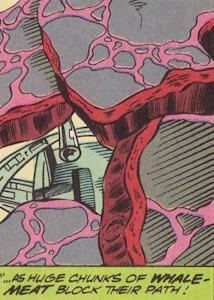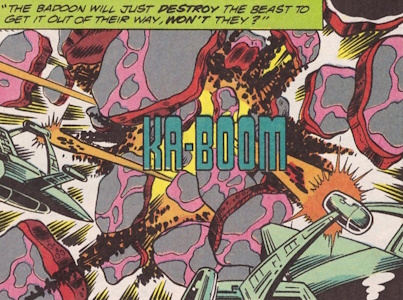

JOVIAN SKY-WHALES
Classification:
Alternate timeline
(Reality-691)
extraterrestrial (Jovian) flying creatures circa the 31st century A.D.
Location/Base of Operations: Upper atmosphere of Jupiter, fifth planet from the
sun in the Sol system of the Milky Way galaxy
Habitat: Gas giant atmosphere
Gravity: 252.8% that of Earth (at its cloud tops)
Atmosphere: Hydrogen, helium, methane, water vapor, ammonia
Known Members: None identified (as non-sapient animals, sky-whales presumably do not even
have names)
Estimated population: Unrevealed
Affiliations: None
Enemies:
Jovian sky-kites;
any non-Jovian beings willing to kill them (like members of the
Brotherhood of Badoon)
or to allow them to be killed (like the Guardians of the Galaxy)
First Appearance: Guardians of the Galaxy Annual I#1/3 (1991)
Powers/Abilities: Jovian sky-whales are able to seemingly float through the air that
makes up the upper atmosphere of Jupiter. Exactly how they do this has not been revealed in-story but there
are several possible explanations.
The most likely is that they are naturally buoyant because their bodies
contain massive air sacs that essentially make them living balloons. They could maintain their buoyancy by
making sure that the density of the gases within their bodies was less than that of the surrounding atmosphere,
thereby giving causing their bodies to be subjected to an upward lifting force. This lesser density could be
accomplished either by pumping any heavier gases from their interiors or by keeping their insides warm.
A less likely explanation would be that the sky-whales possess brains that can somehow
create an anti-gravity field around their bodies, possibly by generating anti-gravitons.
Exactly how sky-whales obtain the energy they need to live has not been
revealed. One possibility is that their nutrition comes from consuming organic molecules that exist naturally
within Jupiter's atmosphere and/or smaller organisms that themselves feed on those organic molecules. This
would mean that the Jovian sky-whales were essentially filter-feeders, like the baleen whales from Earth whose
main food source is plankton.
Another possibility is that the sky-whales are able to use the sunlight that falls upon
them to make the organic molecules they consume out of the surrounding gases. This ability to convert light
energy into chemical energy which they store in organic compounds would make them photosynthetic lifeforms
(photoautotrophs).
It is unclear if sky-whales are able to propel themselves through Jupiter's
atmosphere in any way or if they can only drift with the air currents. If they are capable of powered flight,
then they would presumably achieve this through some form of jet propulsion in which they are able to generate
thrust by contracting internal cavities so as to expel some of the gases from within those cavities in a single
direction.
On the other hand, even if they are incapable of powered flight, then they might still be able to
direct that flight by altering their buoyancy so as to change their altitudes enough to enter wind streams that
are flowing in different directions.
Sky-whales lack any manipulatory appendages and it is not known what type
of sensory organs they might possess. Despite their great size, it is unclear if they possess brains or even
central nervous systems of any complexity. .
Nothing has been revealed about the life cycle of the sky-whales or how
they reproduce.
The only defense mechanism that Jovian sky-whales are known to possess against
predators is their enormous size. However, it's hard to imagine how that would be enough to prevent them from
being snacked on by any hungry sky-kites who happened to encounter them. Perhaps they have some (unobserved)
biological defense that makes it hazardous for predators to try to feed on them while they're alive?
Traits: Jovian sky-whales are large, peaceful animals who seem to spend their lives
feeding as they drift through Jupiter's upper atmosphere.
Type: Radially symmetrical airborne lifeforms ("jellyfish" or "living balloons")
Eyes: Unrevealed (perhaps inapplicable)
Limbs: None
Skin color: Purple with pink
Maximum diameter: 1,800 feet (estimated)
Type of government: Inapplicable. As presumably non-sapient lifeforms, Jovian
sky-whales probably do not have any form of government, but their actions may be governed by some form
of herd behavior which enables groups of them to act collectively without centralized direction.
Level of technology: None
History:
(Guardians of the Galaxy Annual I#1/3 (fb) - BTS) - The species that the Jovians named "sky-whales" apparently
evolved in the upper atmosphere of the gas giant planet Jupiter. No details about their evolutionary path or how
they were discovered and studied by Jovian scientists have been revealed.

(Guardians of the Galaxy Annual I#1/3 (fb) - BTS) - After the discovery of the sky-whales,
knowledge of their existence presumably became well-known to all (or most or many) Jovians.
(Guardians of the Galaxy Annual I#1/3) <3007 A.D.> - When the four original Guardians
of the Galaxy teleported from Earth to one of the Floating Cities of Jupiter in an attempt to acquire a Terran
space vehicle, they were ambushed almost immediately after their arrival by Badoon soldiers stationed there
whose hook-up into the main computer terminal had warned them of the incoming teleport.
Now unable to reach
the Space-Militia air field, the Guardians were forced to steal a Badoon shuttle which they used to escape
from the city dome and into Jupiter's upper atmosphere.
Soon pursued by two Badoon fighters, the Jovian pilot
Charlie-27 decided to use his knowledge of native Jovian lifeforms to destroy the Badoon craft.
Charlie-27 began his plan by locating a big Jovian sky-whale, flying the
shuttle up and over it, and then coming to a dead stop on the other side, placing the sky-whale between them
and their pursuers. As Charlie-27 had anticipated and planned, the Badoon fighters chose to destroy the
sky-whale to get it out of their way, and used their weapons to blast it to pieces.
However, as Charlie-27
had also planned, the huge chunks of whale-meat not only prevented the Badoon fighters from moving for a few
minutes, enabling the Guardians to put some distance between them, the scent of (the blood from) the whale meat
attracted thousands of sky-kites and triggered in them a feeding frenzy that caused them to ferociously attack
everything in their path.
Trapped by the whale meat, the two Badoon fighters were quickly destroyed by the
sky-kites as they consumed the sky-whale's remains.
Comments: Created by Jim Valentino and Steve Montano.
Although casual readers of Guardians of the Galaxy Annual I#1 might have
first noticed the Jovian sky-whales when they appeared and were named on the fifth page of the third story,
they actually appeared one page earlier, in the first panel that depicted what the Guardians of the Galaxy
saw when they arrived on one of the Floating Cities of Jupiter. If you closely examine that image, included
to the right of this paragraph, you can see a number of small round objects drifting among the clouds of
Jupiter, objects that (I believe) are meant to be sky-whales, dwarfed by their surroundings.
That particular panel somewhat resembles a painting called "Hunters, Floaters, Sinkers"
that was painted for and featured heavily in an episode of the 1980 TV series Cosmos.
After Charlie-27 had manipulated the Badoon fighters into destroying the
sky-whale, an angered Yondu objected because the Jovian had caused the death of an innocent creature. However,
Charlie-27 was seemingly indifferent to that death, remarking that it was "Better him than us!" I'm uncertain
if Charlie-27's pragmatic choice was meant to be an expression of his Mil-Man training or if was an indication
that Jovians generally placed little value on the lives of the Jovian sky-whales.
Since I'm not a biologist or even a scientist, I have no idea what type
of animals the sky-whales would be classified as being. Their overall structure somewhat resembles enormous
jellyfish, but what would that make them?
I'm not a biologist or a scientist, either, I
am a veterinary surgeon, and I almost exclusively work on dogs and
cats...I occasionally work on exotic animals for the local zoo. Anyway,
by my limited understanding, jellyfish are part of the phylum Cnidaria
and the sub-phylum Medusazoa within the animal kingdom. However, the
"meat" description of the sky-whales is less consistent with a
jellyfish. Molluscs (like snails and slugs) are a little more
meaty...or maybe they are more like some sort of cephalopod (like a
squid or an octopus) but they keep their tentacles retracted under
normal circumstances.
--Snood
So far, Jovian sky-whales and sky-kites have only appeared in a single
GOTG story that was set in Reality-691. Given how frequently the human species has evolved on the billions
of alternate Earths that exist throughout the Marvel Multiverse, it seems incredibly likely that such Jovian
lifeforms must have evolved on the billions of counterparts of Jupiter-691. However, since none of them have
so far appeared in any other Marvel story, I have chosen to not assume that they must exist throughout the
multiverse, and that is why the classification of this species specifies it as being from an Alternate
Timeline.
Since no statements (aside from "big") were provided about the size of the
Jovian sky-whales, I had to try to make a rough calculation based on measurements of the sizes of the images
in two panels. In the paper version of the main image, the stolen Badoon shuttle is 3 mm long while the "big
Jovian sky-whale" was 78 mm wide. This means that a sky-whale was 26 times as wide as that shuttle's length.
So, how long was the shuttle? I measured it at about 90 mm while the figure of Yondu as he entered it was only
8 mm tall (excluding his crest). Since Yondu's height (excluding his crest) is known to be 6'2", that would
give the shuttle an approximate length of about 69 feet. Multiply that by 26 and the width of the big sky-whale
would be about 1,794 feet.
Origin story
When I first saw the Jovian sky-whales and sky-kites, I was immediately reminded
of some theoretical lifeforms that I had seen on PBS over a decade earlier. In the second episode ("One Voice in
the Cosmic Fugue") of the 1980 TV series Cosmos: A Personal Voyage, astronomer Carl Sagan talked about
the possibility of life on a planet like Jupiter and referenced a paper ("Particles, Environments, and Possible
Ecologies in the Jovian Atmosphere") that he and physicist E.E. Salpeter had written while at Cornell University.
Sagan and Salpeter had made some calculations about the life that might exist on a world like Jupiter and had
come up with three types of life that they called sinkers, floaters and hunters. That episode of Cosmos
presented artistic interpretations of what those lifeforms might look like, and Jim Valentino's sky-whales
and sky-kites show a certain similarity in design to the floaters and hunters that appeared in that episode.
Considering that Mr. Valentino chose to name a (fictional) volcano, Mount Morabito, on the moon Io after Linda
Morabito, the astronomer who first discovered volcanic activity on Io in the real world, it seems odd that the
story did not mention that the design of those Jovian lifeforms may have been inspired by that episode of
Cosmos.
An article about how "Hunters, Floaters, Sinkers" was created can be found
here.
Clips of that segment from that Cosmos episode can also be easily found online, like this video on
YouTube.
Here's a text version of Carl Sagan's narration of that segment about the
life that might exist on a Jovian-type gas giant of a world:
"Think of a world, something like Jupiter, with an atmosphere rich in
hydrogen, helium, methane, water and ammonia, in which organic molecules might be falling from the skies
like manna from Heaven, like the products of the Miller-Urey experiment. Could there be life on such a
world?"
"Well, there's a special problem. The atmosphere is turbulent and, down
deep, before we ever come to a surface, it's very hot. If you're not careful, you'll be carried down and fried.
So one way to make a living is to reproduce before you're fried. Turbulence will carry some of your offspring
to the higher and cooler layers. Such organisms could be very little. We call them sinkers."
"The physicist E.E. Salpeter and I at Cornell have calculated something
about the other kinds of life that might exist on such a world."
"Vast living balloons could stay buoyant by pumping heavy gases from their
interiors or by keeping their insides warm. They might eat the organic molecules in the air or make their own
with sunlight. We call these creatures floaters."
"We imagine floaters kilometers across, enormously larger than the greatest
whale that ever was, beings the size of cities. We conceive of them arrayed in great, lazy herds as far as the
eye can see, concentrated in the updrafts in the enormous sea of clouds."
"But there can be other creatures in this alien environment: hunters. Hunters
are fast and maneuverable. They eat the floaters, both for their organic molecules and for their store of pure
hydrogen."
"But there can't be many hunters because if they destroy all the floaters,
they themselves will perish."
"Physics and chemistry permit such life forms. Art presents them with a
certain reality but nature is not obliged to follow our speculations."
"However, if there are billions of inhabited worlds in the Milky Way galaxy,
then I think it's likely there are a few places which might have hunters and floaters and sinkers."
It should be noted that the chances that such theoretical lifeforms could
actually exist within Jupiter's atmosphere were later greatly diminished. Apparently, some experiments showed
that the forces of convection, powerful gusts in the Jovian atmosphere, would probably blow any promising
molecules into the lower atmosphere where the rigid pressures and intense temperatures would do away with them.
So, the existence of any native life on Jupiter is improbable after all, at least in the real world.
Profile by
Donald Campbell.
CLARIFICATIONS:
The Jovian sky-whales have no known connections to
- the Acanti - a race of enormous sapient "space-whales" (sometimes called "sky-whales")
who live their entire lives in space, are capable of flying through it at faster-than-light speeds and were
(allegedly) among the first forms of life to develop in the Marvel Universe--Uncanny X-Men I#156
- the Amebids - a formerly
sea-dwelling species of cephalopods from the planet Sakaar who have evolved the ability to fly through that
planet's lower atmosphere--Incredible Hulk II#92
- the Limbic
Infundibula - a species (sometimes called "time whales") who are the only lifeform known to be native
to the transtemporal realm of Limbo--Avengers: The Terminatrix Objective#4
- any other immense ("whale-like") creatures
- or any actual whales
images: (without ads)
Guardians of the Galaxy Annual I#1, page 48, panel 8 (main image)
page 49, panel 1 (sky-whale being blasted apart)
page 49, panel 3 (huge chucks of sky-whale meat)
page 47, panel 1 (herds drifting through Jupiter's atmosphere)
Appearance:
Guardians of the Galaxy Annual I#1/3 (1991) - Jim Valentino (writer/artist), Steve Montano (inker),
Craig Anderson (editor)
First Posted: 03/08/2024
Last updated: 03/10/2024
Any Additions/Corrections? Please
let me know.
Non-Marvel Copyright
info
All other characters mentioned or pictured are ™ and © 1941-2099 Marvel
Characters, Inc. All Rights Reserved. If you like this stuff, you should check out the real thing!
Please visit The Marvel Official Site at: http://www.marvel.com
Special Thanks to http://www.g-mart.com/ for hosting
the Appendix, Master List, etc.!
Back to Extraterrestrial Races



